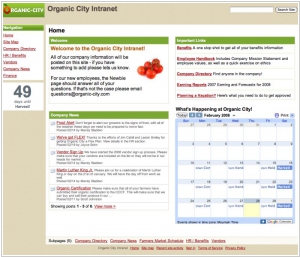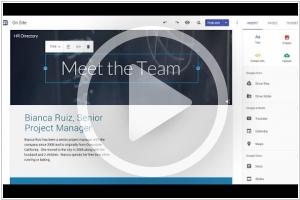Confluence vs Google Sites
April 19, 2023 | Author: Adam Levine
29
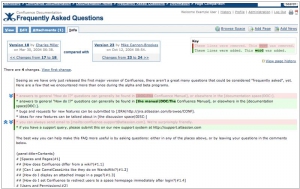
Confluence provides one place for technical teams to collaborate—create, share, and discuss your ideas, files, minutes, specs, mockups, diagrams, and projects. A rich editor, deep Office and JIRA integration, and powerful plugins help teams collaboratively develop technical docs, intranets, and knowledge bases.
Confluence and Google Sites are both web-based collaboration tools used for creating and sharing content within teams and organizations, but they are offered by different companies and have some key differences in terms of features, functionality, and integration:
Features: Confluence, developed by Atlassian, is a comprehensive team collaboration platform that focuses on content creation, organization, and collaboration. It offers features such as document creation, knowledge base management, team collaboration spaces, task management, and integrations with other Atlassian products like Jira and Trello. Confluence is known for its robust content management capabilities, rich text editing, and extensive customization options.
Google Sites, on the other hand, is a simpler website building tool offered by Google that allows users to create basic web pages without much customization or advanced features. It is more focused on creating simple websites for sharing information, announcements, or basic content within a team or organization. Google Sites offers features such as easy drag-and-drop page creation, integration with other Google Workspace (formerly G Suite) tools, and basic customization options.
Functionality: Confluence is designed as a centralized platform for team collaboration, knowledge sharing, and documentation. It provides a wide range of tools and features to create, organize, and manage content in a collaborative manner. Confluence allows teams to create and edit documents, add comments, create tasks, and collaborate on content in real-time. It also offers advanced permission settings, versioning, and content moderation features.
Google Sites, on the other hand, is more limited in terms of functionality and customization options. It offers basic web page creation and customization features, but it may not be suitable for more complex content management needs or large-scale team collaboration.
Integration: Confluence is well known for its integrations with other Atlassian products, such as Jira (for issue tracking and project management), Trello (for visual project management), and Confluence Questions (for Q&A and knowledge base). It also offers integrations with third-party tools through its marketplace, allowing users to connect Confluence with other tools they use in their workflow.
Google Sites, on the other hand, integrates seamlessly with other Google Workspace tools, such as Google Drive (for file storage and sharing), Google Docs, Sheets, and Slides (for document editing and collaboration), and Google Calendar (for scheduling and event management).
In summary, the main differences between Confluence and Google Sites are features, functionality, and integration. Confluence is a comprehensive team collaboration platform with robust content management capabilities, while Google Sites is a simpler website building tool with basic features. Confluence offers extensive integrations with other Atlassian products and third-party tools, while Google Sites integrates seamlessly with other Google Workspace tools. Users should consider their specific collaboration and content management needs when choosing between the two tools.
See also: Top 10 Wiki software
Features: Confluence, developed by Atlassian, is a comprehensive team collaboration platform that focuses on content creation, organization, and collaboration. It offers features such as document creation, knowledge base management, team collaboration spaces, task management, and integrations with other Atlassian products like Jira and Trello. Confluence is known for its robust content management capabilities, rich text editing, and extensive customization options.
Google Sites, on the other hand, is a simpler website building tool offered by Google that allows users to create basic web pages without much customization or advanced features. It is more focused on creating simple websites for sharing information, announcements, or basic content within a team or organization. Google Sites offers features such as easy drag-and-drop page creation, integration with other Google Workspace (formerly G Suite) tools, and basic customization options.
Functionality: Confluence is designed as a centralized platform for team collaboration, knowledge sharing, and documentation. It provides a wide range of tools and features to create, organize, and manage content in a collaborative manner. Confluence allows teams to create and edit documents, add comments, create tasks, and collaborate on content in real-time. It also offers advanced permission settings, versioning, and content moderation features.
Google Sites, on the other hand, is more limited in terms of functionality and customization options. It offers basic web page creation and customization features, but it may not be suitable for more complex content management needs or large-scale team collaboration.
Integration: Confluence is well known for its integrations with other Atlassian products, such as Jira (for issue tracking and project management), Trello (for visual project management), and Confluence Questions (for Q&A and knowledge base). It also offers integrations with third-party tools through its marketplace, allowing users to connect Confluence with other tools they use in their workflow.
Google Sites, on the other hand, integrates seamlessly with other Google Workspace tools, such as Google Drive (for file storage and sharing), Google Docs, Sheets, and Slides (for document editing and collaboration), and Google Calendar (for scheduling and event management).
In summary, the main differences between Confluence and Google Sites are features, functionality, and integration. Confluence is a comprehensive team collaboration platform with robust content management capabilities, while Google Sites is a simpler website building tool with basic features. Confluence offers extensive integrations with other Atlassian products and third-party tools, while Google Sites integrates seamlessly with other Google Workspace tools. Users should consider their specific collaboration and content management needs when choosing between the two tools.
See also: Top 10 Wiki software
Confluence vs Google Sites in our news:
2023. Atlassian brings an AI assistant to Jira and Confluence
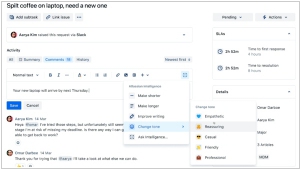
Atlassian has introduced Atlassian Intelligence, an AI-powered 'virtual teammate' that utilizes the company's proprietary models and OpenAI's large language models to create customized teamwork graphs. This technology enables various functionalities, such as AI-generated summaries in Confluence and test plans in Jira Software, as well as the rewriting of responses to customers in Jira Service Management. Atlassian Intelligence provides users with a chatbox similar to Chat-GPT, which is deeply integrated into different products and allows for the referencing of specific documents. For instance, to generate a summary of action items from a recent meeting, users can link the document with the transcript and request the summary inside Confluence. The tool then generates a list of decisions and action items from the meeting.
2021. Atlassian peps up Confluence with new graphical design features
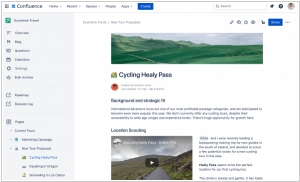
Confluence, the collaborative workspace developed by Atlassian, has been a staple knowledge-sharing tool for over 15 years, widely adopted by companies for its versatility. In its latest update, Confluence introduces several new features to enhance user experience. Users can now customize their spaces with cover images, title emojis, and personalized avatars that represent different sections of Confluence. The addition of smart links allows for seamless integration with platforms like YouTube and Trello, automatically recognizing and displaying links in their native formats. Furthermore, users can schedule the publication of new pages and convert pages into blog posts, reflecting the increasing popularity of corporate blogging within organizations, particularly for internal audiences during the pandemic.
2020. Atlassian’s Confluence gets a new template gallery
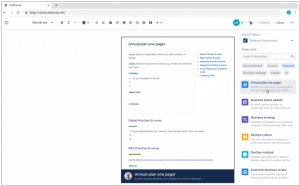
Confluence, the content-centric collaboration tool by Atlassian, is simplifying the onboarding process for new users through the introduction of an enhanced template gallery, featuring 75 additional templates. This update signifies the evolution of Confluence from a specialized wiki primarily used by technical documentation teams to a widely adopted tool utilized across various organizations. The revamped template gallery offers improved search tools, filters, and previews conveniently located in the right-hand panel of your Confluence site. These enhancements facilitate the seamless discovery of templates that are most relevant to your business needs.
2018. Google Sites now lets you publish protected content
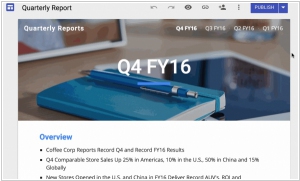
Google has introduced a significant update to its website-building platform, Google Sites, offering organizations greater control over content access. With this update, creators and administrators now have the ability to selectively choose who within their organization can view specific sites. By entering individual names in the "Invite People" box and selecting "Specific people can view when published" from the drop-down menu, organizations can determine the audience for their content. This update is particularly important as it enables organizations to maintain privacy and control over confidential information, thereby encouraging the adoption of the new Google Sites. Currently, this feature is available exclusively on the web, but Google has announced that it will be extending its availability to the Google Drive mobile apps on Android and iOS in the coming weeks.
2016. Totally rebuilt Google Sites features adaptive design and real-time collaboration
Google has introduced a completely revamped version of its intranet website builder, called Google Sites. This new iteration offers deep integration with Google's suite of tools, allowing for easy insertion of documents from Google Docs, Slides, Sheets, and other G Suite applications. Additionally, Google Sites now directly integrates with Google Analytics for comprehensive website analytics. Collaborative editing capabilities have also been introduced, leveraging the same technology used in Google Docs, enabling multiple users to work together on site content. Administrators have the flexibility to determine whether users can publish their sites publicly or restrict access to users within their own domain. With this update, the created pages on Google Sites automatically adjust to different screen sizes, ensuring optimal viewing experiences on various devices. The preview mode further simplifies the process of assessing site appearance on phones, tablets, and desktops. To assist users in achieving a professional look, Google has included six new themes to serve as starting points for website design.
2014. Atlassian launches JIRA and Confluence for large companies
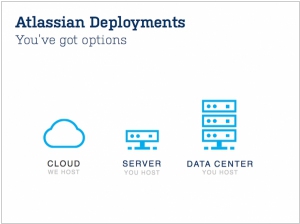
Atlassian has unveiled two new products designed specifically for large enterprises. In the upcoming week, Atlassian will release JIRA Data Center, a version of its project management software that supports running the service on multiple nodes. Additionally, later this summer, it will introduce Confluence Data Center, a collaboration service centered around wikis. With the Data Center versions, larger companies will enjoy improved support for scaling the services across multiple nodes, resulting in enhanced performance and scalability. Administrators will have the ability to route specific applications, teams, or geographies to designated nodes within a cluster, while additional nodes can be added in real time. The clustering technology and shared file systems are seamlessly integrated with industry-standard technologies, ensuring smooth operations.
2011. Google wants to mobilize business sites
For those businesses that still don't realize that the great majority of their customers coming (or would like to come) to their site via smartphones, Google launched the new initiative GoMo. This service allows you to see how your site looking in the mobile browser and find an appropriate service for building mobile site version (Google Sites is also in the list). Who should think about the mobile site version? First of all, it's online stores. Because browsing stores on a smartphone - is the most popular activity among those sitting in a toilet. Second, that are local businesses: cafes, restaurants, hotels, shops, medical services, hair salons, car repair ... - all the things that city visitor or local inhabitant may need. ***
2011. JIRA, Confluence available as SaaS services
Atlassian has launched the new SaaS service Atlassian OnDemand, which includes its popular tools for managing software development projects: JIRA (issue-tracker), Confluence (wiki), GreenHopper (Agile Project Management), Bonfire (bug reporter), FishEye (code manager), Crucible (code review) and Bamboo (integration). All products in the SaaS version provide the full functionality of the installable counterparts. There are only minimal restrictions on the tool integration and use of the custom plug-ins. You can turn on/off the tools as needed. The service pricing is traditional for Atlassian - "everything for $10 for 10 users." Recall that the company is also selling the 10-user leniences of the same installable products for $10. So you can either buy the product for $10, or rent it for $10/month. ***
2011. Google Sites now allows to create mobile landing pages
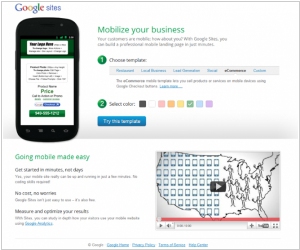
Google is introducing a new feature in Sites that enables users to create a free, simple mobile landing page. Similar to the templates available for Google Sites web pages, Sites for Mobile provides users with a selection of templates tailored to their specific needs. For instance, there are e-commerce templates for users who wish to create a mobile site for selling products using Google Checkout. Google also offers customized mobile templates for local businesses, restaurants, lead generation, and social purposes. These mobile sites allow businesses and users to integrate their Facebook, Twitter, YouTube, LinkedIn, and other social media accounts. Additionally, users can include features such as phone numbers, directions to their business, coupons, menus, and more. Businesses will also have access to analytics to track the traffic to their mobile sites.
2010. Google Sites vs Zoho Projects for project management in Google Apps
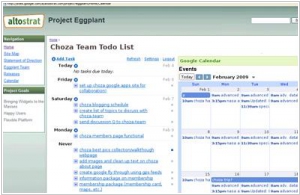
As you know, Google Apps has no specialized project management solution, and this is very disappointing, as there are many other useful utilities for online workgroups there. However, there are three tools that can be used to solve this problem. And the first of them is Google Sites. You can use Google Sites to manage one large project, or create a site for each small project in it (there are even some templates for project sites). Since Google Sites is, in fact, a wiki, you can easily work with the project documentation there. In addition, Google Sites allows you to embed group calendar (Google Calendar), task list (Google Tasks) and documents from Google Docs. All these elements are very useful for project management, but of course, task collaboration in this solution - is the weakness. ***

